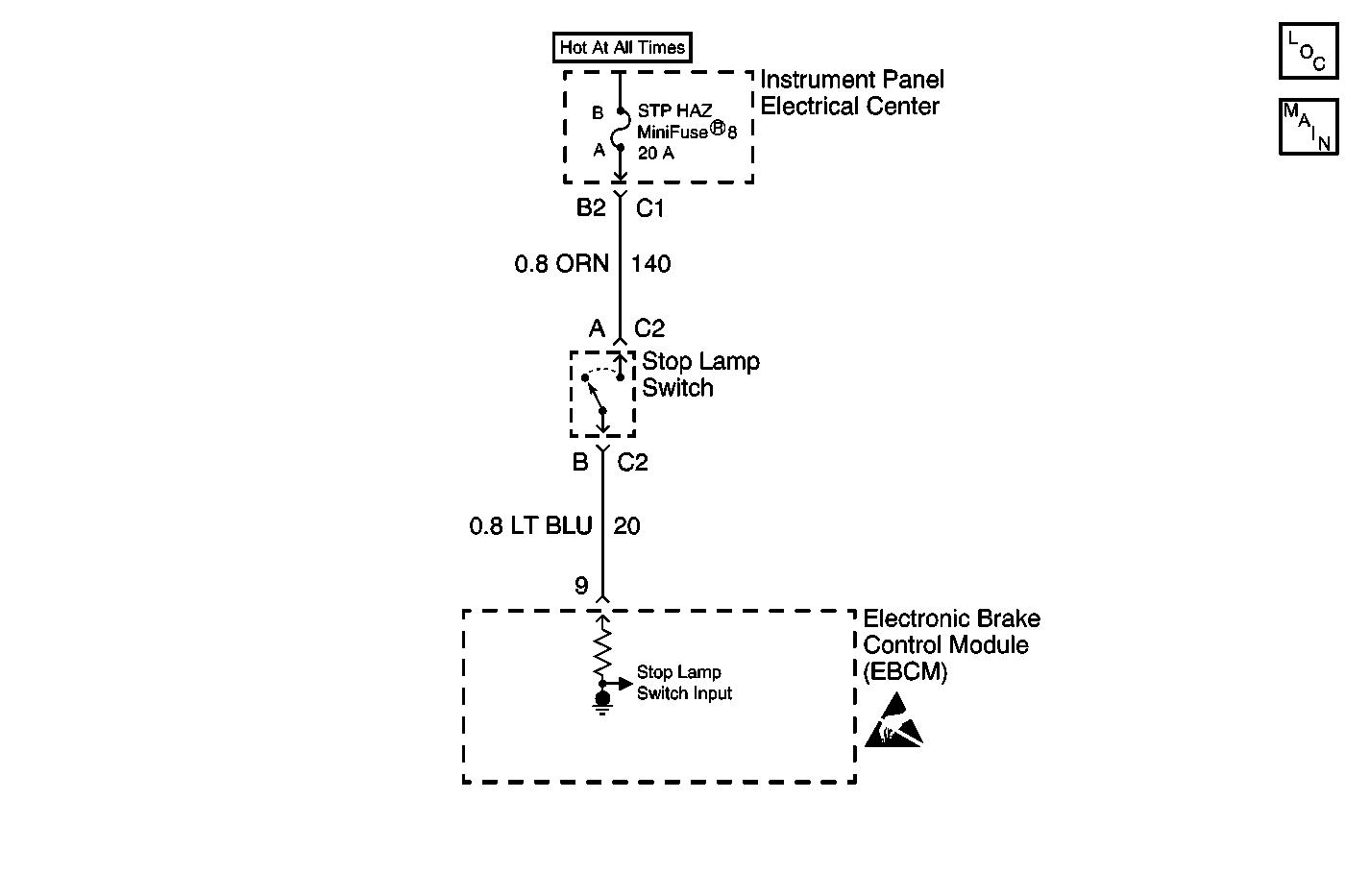
Circuit Description
This circuit is used to detect an open Stoplamp Switch in the non-ABS mode. The EBCM looks for a deceleration rate that would indicate braking action and verifies this assumption by requiring several repeats of this detection method. In each case, TCS/Active Handling (if equipped with RPO JL4) will not be available since no Stoplamp Switch voltage is seen by the EBCM.
Conditions for Setting the DTC
DTC C1291 is set after the stoplamp switch remains open for three deceleration cycles.
Action Taken When the DTC Sets
ABS remains enabled, TCS/ Active Handling™ (if equipped with RPO JL4) are disabled.
| • | Indicators that turn on: |
| Car Icon (TCS indicator) |
| • | Messages displayed on the DIC: |
| Service Traction System |
| Service Active HNDLG (if equipped with RPO JL4) |
Conditions for Clearing the DTC
| • | Condition for DTC is no longer present and scan tool clear DTC function is used. |
| • | Fifty ignition cycles have passed with no DTCs detected. |
Diagnostic Aids
| • | It is very important that a thorough inspection of the wiring and connectors be performed. Failure to carefully and fully inspect wiring and connectors may result in misdiagnosis, causing part replacement with reappearance of the malfunction. |
| • | If any Wheel Speed Sensor DTCs are present you must diagnose them first. |
| • | An intermittent malfunction is most likely caused by a poor connection, rubbed through wire insulation, or a wire that is broken inside the insulation. |
| • | If an intermittent malfunction exists refer to Testing for Electrical Intermittents in Wiring Systems. |
| • | Possible causes: |
| - | Open stoplamp switch |
| - | Open fuse |
| - | Stoplamp switch misadjusted |
| - | Erratic wheel speeds |
| - | Circuit has a wiring problem, terminal corrosion, or poor connections |
Test Description
The numbers below refer to step numbers on the diagnostic table.
-
Checks if Stoplamp Switch and power distribution are OK.
-
Checks for voltage at EBCM.
-
Checks the Stoplamp Switch.
Step | Action | Value(s) | Yes | No |
|---|---|---|---|---|
1 | Was the Diagnostic System Check performed? | -- | ||
2 | Are any Wheel Speed Sensor DTC(s) present? | -- | Go to Applicable DTC table. Go to Diagnostic Trouble Code (DTC) List/Type | |
Press the brake pedal. Do the brake lights come on? | -- | |||
Is the voltage within the range specified in the value(s) column? | Battery voltage | |||
5 | Replace the EBCM. Refer to Electronic Brake Control Module Replacement . Is the replacement complete? | -- | -- | |
6 | Repair open in CKT 20. Refer to Wiring Repairs in Wiring Systems. Is the repair complete? | -- | -- | |
7 | Check the STOP/HAZ fuse in the Instrument Panel Electrical Center. Is the fuse OK? | -- | ||
8 |
Is the voltage within the range specified in the value(s) column? | Battery voltage | ||
9 | Repair CKT 140 for an open. Refer to Wiring Repairs in Wiring Systems. Is the repair complete? | -- | -- | |
Connect a fused jumper wire between terminals A and B of the Stoplamp switch harness connector. Do the brake lamps come on? | -- | |||
11 | Adjust or repair the Stoplamp switch as necessary. Refer to Stop Lamp Switch Adjustment in Hydraulic Brakes. Is the repair complete? | -- | -- | |
12 |
Is the fuse OK? | -- | ||
13 | Repair short to ground in CKT 140. Refer to Wiring Repairs in Wiring Systems. Is the repair complete? | -- | -- | |
14 |
Is the fuse OK? | -- | ||
15 |
Is the fuse OK? | -- | ||
16 | Repair CKT 20 for a short to ground. Refer to Wiring Repairs in Wiring Systems. Is the repair complete? | -- | -- |
